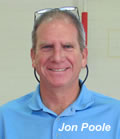Proving our Worth: The
Challenge of Teacher Evaluation
written by Steve
Shelton & Jon
Poole, Radford University, Radford, VA
It appears an easy question on the
surface; what can we expect our students to know and be able
to do when they leave our programs? It's the answer, of course,
which is so difficult. Our state and national standards
provide guidance by defining
a physically educated person. You might even be lucky enough
to have a progressive local school district such as Loudoun
County, Virginia help with a curriculum guide.
Yet, ultimately it comes down to a dedicated and well-prepared
teacher willing to challenge young people to learn the skills,
gain the knowledge, and demonstrate the appropriate attitudes
needed to lead a physically active and healthy lifestyle.
Closely allied with the assessment
of our students, in an attempt to determine if they have learned
what we taught, comes the challenge of evaluating teachers
based on student learning. This challenge has been well documented
over the years in physical education by many of our fields
strongest scholars (Metzler, 2011; Rink, 2006; Siedentop &
van der Mars, 2012). Our National Association for Sport and
Physical Education (NASPE) has even dedicated significant
resources to the PEMetrics
program which lists as one of its goals to "provide
information to parents that shows them that teaching and learning
are happening in physical education."
For those of us working in physical
education teacher education (PETE) programs, this challenge
is magnified as our program accreditation is tied to our ability
to document that our students can meet teaching standards
identified by NASPE in conjunction with the National Council
of the Accreditation of Teacher Education (NCATE). A primary
performance assessment used for programs seeking NASPE/NCATE
accreditation is known as a "Teacher
Work Sample." According to NASPE (2009), the teacher
work sample "is a unit of instruction that provides an
opportunity to demonstrate that the pre-service teacher can
cause learning to take place within their student teaching
experience" (p. 1).
Think about some key words in that
sentence above, most notably that a teacher can "cause"
learning to occur. Our use of the word "proving"
in the title of this article was not by accident. It is our
belief that physical educators are at a critical crossroads
relative to teacher evaluation. Gone are the days, we believe,
that simply keeping children busy, happy, and good (Placek,
1983) would be good enough to keep jobs secure and programs
viable. Put another way, while we all want children to try
hard and have fun in our classes, if we cannot share our worth
as essential to the education of a child, then we should not
be surprised when someone questions our role in a school.
Accountability is at an all-time high in education, and it
is critical that both current teachers and those students
soon graduating from PETE programs are adequately prepared
to "prove" that their teaching improved student
learning.
Our home state of Virginia has taken
a significant step in teacher evaluation, mandating
that starting this academic year (2012-2013) evidence of student
academic progress accounts for 40% of individual teacher's
summative evaluation. While incorporating multiple measures
of student academic progress is expected, teachers of reading
and math must use a state growth measure known as student
growth percentiles. The State acknowledges that "less
than 30 percent of teachers in Virginia's public schools will
have a direct measure of student academic progress available
based on Standards of Learning assessment results" (p
42).
Physical and health education are
two of those areas in which we have Standards of Learning
that should guide teacher decision making relative to curriculum
and instruction, yet no state-wide test exists. Thus, our
teachers will choose to incorporate multiple measures of student
academic progress based on a set of target goals for student
improvement. The state refers to this as student achievement
goal setting, and it is designed to improve student learning.
In working with several local school
teachers, we've tried to share the following advice. Be careful
to set goals that the teacher and students will benefit from
without creating a "monster" unnecessarily. Talk
with the principal about whether or not one class (instead
of the entire student population) can be used as a manageable
way to measure "student academic progress" and meet
stated student achievement goals.
We have encouraged teachers to avoid
solely using fitness test scores (most often the PACER) as
their only assessment in this process. It has been our experience
that often no more than 10% of class time with students throughout
the year is dedicated to administering physical fitness testing.
So, do we really want 100% of our evaluation based on what
we do during 10% of our time? Think instead about what teachers
are doing with the other 90% of the year, and decide how to
measure student academic progress toward whatever goals the
program might have in place.
Rink (2010) reported that "physical
education has responsibility for all domains of learning"
(p. 3). As physical educators decide how to find meaningful
ways to assess and document student learning, it might be
advantageous to measure progress across all three learning
domains; psychomotor, cognitive, and affective. Actually,
because of the breadth and complexity of the psychomotor domain,
some professionals have even separated health-related physical
fitness from the skill-related components of fitness and the
psychomotor domain to create a fourth "sphere" of
learning; the health-related physical fitness domain (Annarino,
Cowell, & Hazelton, 1980; Lacy & Hastad, 2007). In
doing so, teachers might profit from separating learning into
these four areas, then designing specific assessments for
each.
As previously mentioned, only assessing
fitness outcomes from the health-related physical fitness
domain does not report all that students know and are able
to do in physical education, even though it might be attractive
to do so because the data is already being collected each
year. Pangrazzi and Beighle (2013) warned against unrealistic
expectations for students to reach specific fitness standards.
Test performance for children might be explained more by maturation
than training, opportunities to practice, and encouragement.
The authors reported, "most of the improvement teachers
see when they compare their students' results from the fall
to their results from spring is due to the kids being 8 or
9 months older" (p. 253). This is not to say that fitness
outcomes should be completely overlooked. While including
fitness measures in an overall assessment is important, we
suggest looking beyond using fitness scores exclusively as
the only measure of a program's worth and of a teacher's effectiveness.
Measuring psychomotor objectives appears
to be important because this is a primary focus of instruction
for many physical educators, as students spend most of their
time learning motor skills and the related performance components
such as balance, agility, and coordination. The development
of fundamental movement patterns afford students the opportunity
to develop specialized skills needed to participate in sports.
Using authentic assessments to document the improvement of
targeted skills near the beginning and end of an activity
unit is worth pursuing, and can provide powerful feedback
for students as well. After all, if students do not receive
feedback regarding performance, how will they know if they
are performing well or not in class? Both the teacher and
students should be the beneficiaries of assessment results.
Traditionally, the cognitive domain
is most often evaluated with written tests. Knowledge of rules,
strategies, skill techniques, and the concepts of movement
and fitness are essential to measure. Students who can recognize,
recall, create, and understand the intricacies of specific
games and activities may enjoy more success during complex
game situations. Many physical educators decide against using
written assessments in the gymnasium because of the added
logistics of handing out and taking up clipboards, paper,
and pencils, along with an already long list of needed equipment
for the daily lesson.
However, a local teacher in our area
who used a 10 question pre- and post-test before and after
carefully selected activity units (please see Tchoukball
Pre- and Post-Test at the end of this article) discovered
the assessments were relatively easy to administer. The results
(please see Tchoukball Cognitive Assessment Results
and Tchoukball Cognitive Assessment Individual Question
Results at the end of this article) overwhelmingly provided
evidence of student learning, and the students enjoyed taking
more ownership of their learning, similar in nature to what
they experience regularly in core subject areas. Additionally,
the teacher found the pre-test served as a wonderful preview
of what was coming in the subsequent weeks, adding a layer
of excitement and anticipation that was missing prior to the
implementation of the pre-tests.
The affective domain which deals with
feelings, beliefs, attitudes, and values can be assessed with
the use of attitudinal surveys. Do students like physical
education? How do we know for sure? Intuitively, it may appear
as though the majority of students display favorable feelings
towards activity; however the same local teacher referenced
earlier in this article recently used the Feelings about
Physical Activity Inventory, created by Brian Nielsen
and Charles
Corbin, which quantified how students felt about activity
and participation.
The inventory consists of 12 statements
that may or may not describe a student's feelings about physical
activity. Directions encourage students to rate their feelings
ranging from "strongly agree" to "strongly
disagree" using a five-point scale (Lacy & Hastad,
2007). The findings were encouraging as each of the three
grade levels consistently reported "very favorable feelings
about physical activity," the best possible outcome.
Thus, the affective learning domain should not be overlooked
as a source of valuable information that might be included
in a teacher evaluation portfolio, particularly if a pattern
of improvement is identified.
Another method to evaluating students'
across all learning domains is to authentically assess students
using a design that combines all learning domains on a single
document (please see Tchoukball Authentic Assessment Rubric
at the end of this article). This approach can be used to
measure progress of targeted individuals or small student
groups.
Evaluating students during regular
activity allows the physical educator to move beyond the traditional
mindset of viewing assessment as a separate endeavor that
requires extra time and resources to manage. Lacy and Hastad
(2007) reported that authentic assessment "is used to
describe assessment that takes into account the context of
the game or sport, and is more likely to measure students'
ability to actually play a game rather than their ability
to perform isolated game skills" (p. 107). With practice,
assessment and activity can and should take place simultaneously.
Students should leave physical education
class knowing and being able to do things they couldn't before.
Teachers must find creative and time efficient ways to document
this learning, not only because updated teacher evaluation
protocols now require it, but because it is the essence of
what we are about as movement educators. In this new era of
heightened accountability, where physical educators must increasingly
prove their merit, the suggestions provided within this article
are intended to provide a template for assisting our colleagues
through this complex process. Physical education teachers
must justify program existence with quantifiable outcomes.
Professional opinions and philosophical beliefs cannot be
the only things that sustain our programs moving forward.
references
(back
to pelinks4u homepage) |





